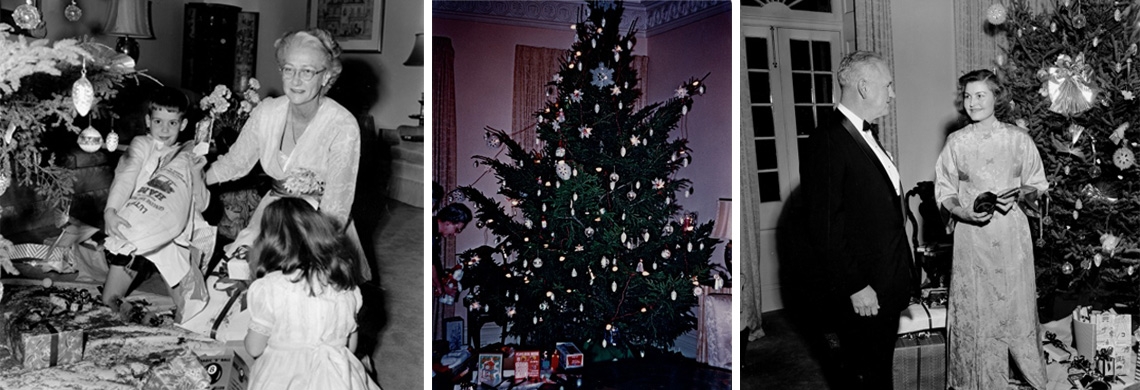Decorative Arts Curator Lydia Blackmore explains THNOC's holiday decorating traditions.
Every year, on the first Monday after Thanksgiving, we transform THNOC’s Royal Street campus from a semitropical oasis of art and history to a semitropical winter wonderland. It’s Christmas Tree Day! We receive and decorate two large, live trees: a 9-foot tree for the Williams Residence living room—the home of our founders—and a 14-foot tree for the Counting House. The day after, Joey Landry of Arbor House Floral arrives to swag balconies and stair railings with greenery and top it all off with beautiful wreaths on the light posts in each courtyard.
The Counting House comes first
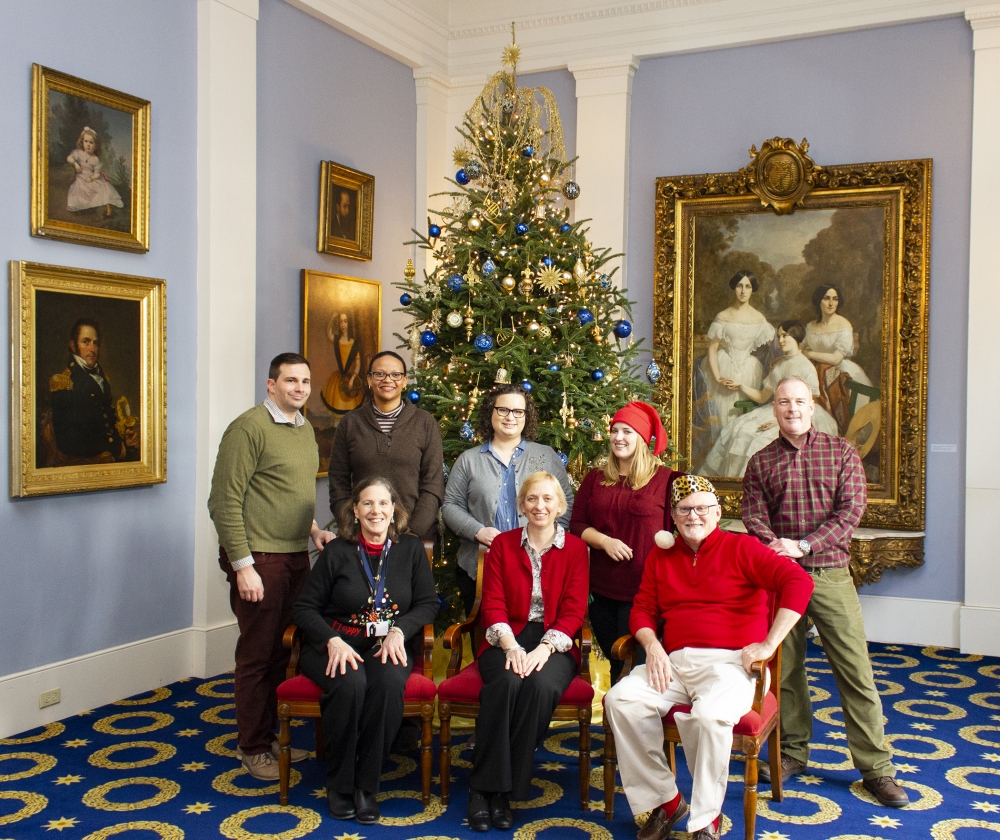
The Counting House team decorates the stately tree in the neoclassical banking hall-turned portrait gallery.
Led by Director of Development and Community Relations Jack Pruitt, the decorating team includes members from the development, museum programs, photography, administration, and technology departments. (Yes, anyone can put lights on a Christmas tree, but our tech team does it with special flair!) We follow a decorating theme of blue and gold ornaments, to match the neoclassical carpet in the Counting House. Bolstered by cookies and punch, and overseen by Louisiana portraits, the large tree is fully decorated within two hours.
The Williams Residence: More than a Christmas Tree
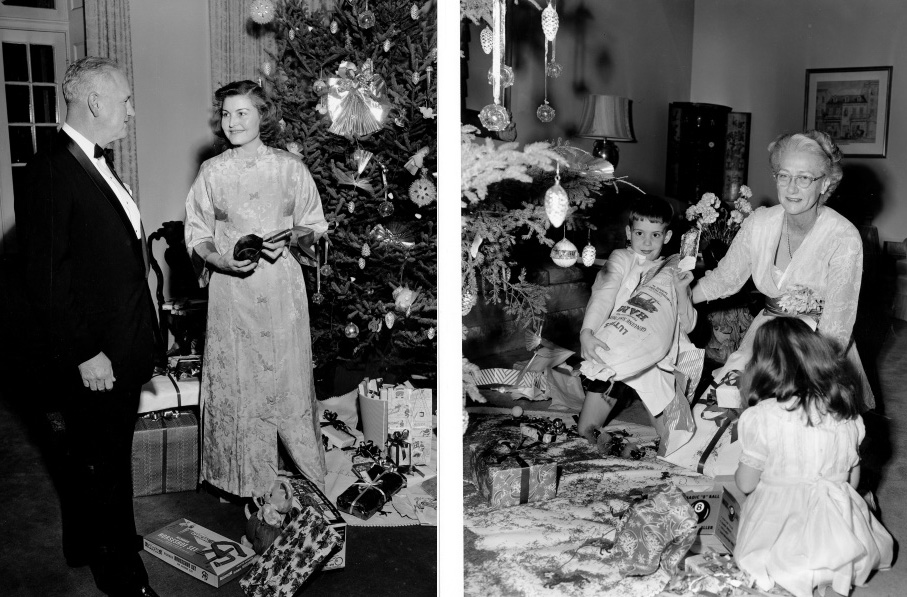
These personal photographs offer details of the Williamses’ Christmases. Leila Williams is on the right with her great-nephew “hamming” it up.
Decorating the tree in the Williams Residence is a little different because it is part of the interpretation of the historic house museum. Kemper and Leila Williams made the French Quarter their home from 1946 to 1964. Although they had a summer house in Santa Barbara, California, a cottage in Patterson, LA, and the option to travel wherever they wanted, they spent their Christmases in New Orleans. Each year on Christmas Eve, they hosted a large party for family and friends, with gifts for children, drinks for adults, and family photographs. The Williamses hired a professional photographer to document their annual Christmas gathering, leaving us a fantastic record of their home furnishings and entertaining style.
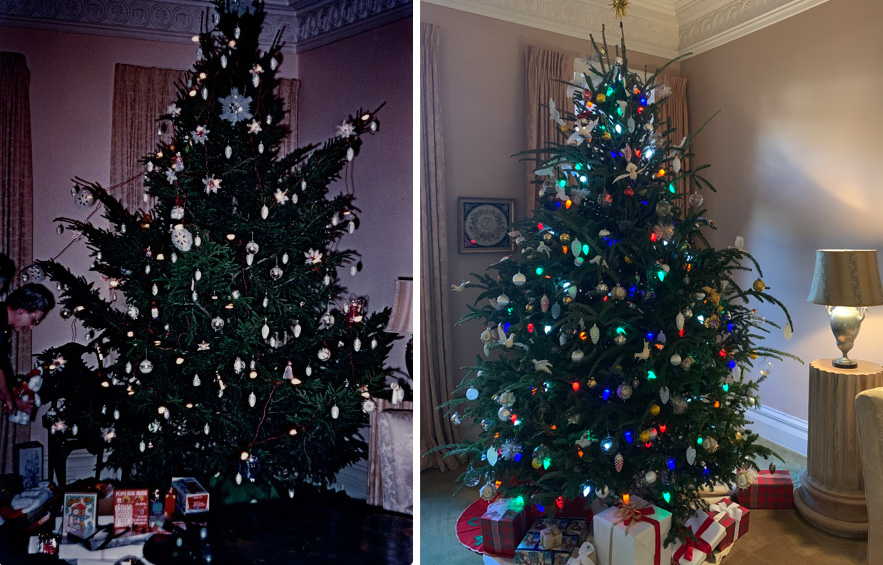
I use the vintage photos to position the tree in the exact same place as it was when the Williamses inhabited the residence, judging by the placement of their furniture and the adjacent walls.
Today, the 9-foot Fraser fir sits in the corner of the living room, to the left of the couch, just as it appears in the photographs from the Williamses’ Christmas parties. Further continuing the Williamses’ tradition, the same ornaments that hung on their tree over half a century ago continue to decorate the tree today, making the live tree not only a piece of holiday cheer but also an exhibition installation. As with any exhibition, installing (decorating) the Williamses’ Christmas tree requires object care and handling, teamwork from several museum departments, and research.
What’s in an ornament?
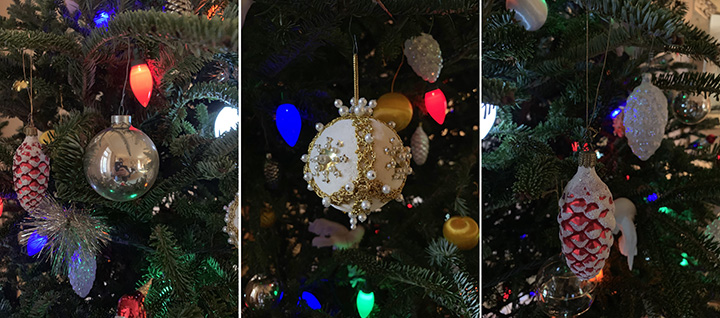
American Shiny Brite ornaments, Japanese balls covered with gimp and pins, and Bohemian pinecones all coexist on the Williamses’ tree.
As a material culture scholar, the best resources I have to interpret the Williamses’ Christmas traditions are the family’s ornaments themselves. Their choice of ornaments tells us about their personal taste, as well as the prevailing styles of the 1940s, 50s, and 60s. There are yellow and white thread-wrapped balls; silver nitrate globes; silver, red, and white glass pinecones; and puffs of tinsel, all of which appear in the Williamses’ Christmas photos. Besides these traditional ornament shapes, there are also a variety of decorative birds, some made of glass or ceramic, and others made of paper and feathers.
The ornaments provide evidence of global trends in mass production and consumerism in the mid-20th century. The glass pinecones decorated with silver nitrate and glitter (my favorite of the ornaments) were manufactured in Czechoslovakia and Germany, where production of lustrous Christmas ornaments began by the turn of the 20th century. The blown glass balls are all American made, probably ca. 1955; some are by the Shiny Brite Company, the most popular mid-century manufacturer of American ornaments. In the late 1930s, with war looming in Europe, American businessman Max Eckardt anticipated a disruption in the supply of German glass ornaments and partnered with Corning Glass to establish a domestic source. Shiny Brites were a patriotic choice, with each clasp marked “Made in the U. S. of A.” Other glass ornaments in the Williamses’ collection were manufactured by the Rauch Company of Gastonia, North Carolina, which is still in operation today.
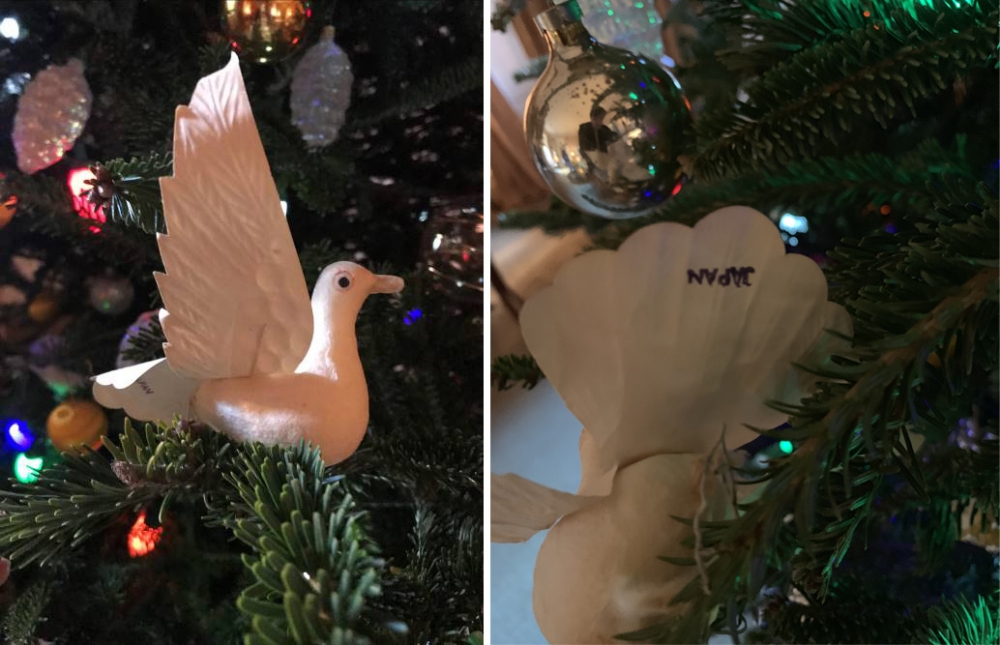
Delicate paper birds cling to the tree branches and are stamped with “JAPAN” to denote their country of origin.
Many of the remaining ornaments were made in Japan, a center of postwar mass production. Cloth-covered balls, decorated with gimp and pins, bear tiny tags from Japan, and each of the delicate paper birds has “JAPAN” stamped under the tail. The birds perch on branches, secured by wires in their feet. Other bird ornaments, made with iridescent glass bodies and bottle brush tails, were probably manufactured in Japan as well. Japanese manufacturing took off in the postwar era, bolstered by support from the United States in an effort to stave off communism. Purchasing Japanese ornaments made for the American market would have been a capitalist statement in more ways than one.
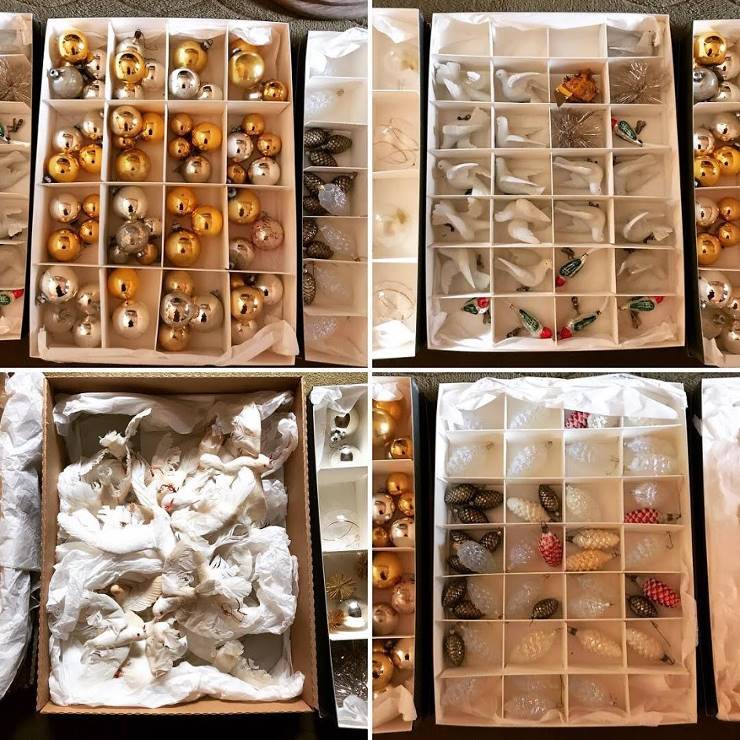
The ornaments look so good in their archival boxes I almost don’t want to put them on the tree.
Archival boxes with acid-free tissue padding and dividers keep the fragile glass balls and pinecones safely nestled when not on view. These boxes are stored in the “Christmas Closet” upstairs in Leila’s bathroom, and I bring them down in the 1945 Otis elevator each year. Laying out the boxes across the living room floor and seeing all of the vintage glitter and gleam from the stored ornaments warms my museum nerd heart each year.
When the appointed hour arrives, the Williams Residence Christmas Tree Team assembles to the sound of vintage holiday tunes. Members of the registration, museum programs, education, and marketing departments bring their respective strengths to the task of curating the installation.
Exhibition installation (Decorating)
I always need some help reaching the top of the tree. Being a curator is a physical job!
Before the ornaments go on the tree, we wrap it in colorful lights. (For safety purposes, in 2015 we replaced the vintage string lights with reproduction vintage-style LEDs.) After the lights, I climb to the top of the ladder to place the original gold foil star on the top of the tree. Then we put on the ornaments, hooking baubles on light twigs and perching the birds on the strongest branches. (Every year, I think of Alfred Hitchcock.)
The final touches are placing the two vintage tree skirts that overlap around the base of the tree. The larger skirt is white, with appliqued scenes of Santa in a horse-drawn carriage and a glitter inscription, “Home for Christmas.” A smaller red felt skirt has festive trees, wreaths, angels, and Santa’s sleigh. These skirts are topped with prop gifts (archival boxes with wrapping paper) laid out for the enjoyment of museum guests throughout the season.
By the end of Christmas Tree Day, I have carried boxes of ornaments, climbed ladders to the tops of trees, and crawled underneath them. I usually have some glitter and pine needles stuck to my hair and sweater. It is a long, hard day, but one full of beautiful objects, collegial teamwork, and plenty of sparkle.
Blackmore is in charge of the interpretation of the Williams Residence. For more on the Williams Residence, take a Holiday Home and Courtyard tour during the month of December, which focuses on the couple’s Christmas and New Year’s traditions.

